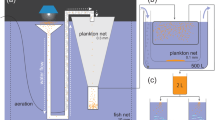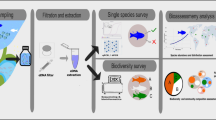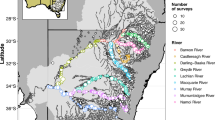Abstract
Pakistani marine waters are under an open access regime. Due to poor management and policy implications, blind fishing is continued which may result in ecological as well as economic losses. Thus, it is of utmost importance to estimate fishery resources before harvesting. In this study, catch and effort data, 1996–2009, of Kiddi shrimp Parapenaeopsis stylifera fishery from Pakistani marine waters was analyzed by using specialized fishery software in order to know fishery stock status of this commercially important shrimp. Maximum, minimum and average capture production of P. stylifera was observed as 15 912 metric tons (mt) (1997), 9 438 mt (2009) and 11 667 mt/a. Two stock assessment tools viz. CEDA (catch and effort data analysis) and ASPIC (a stock production model incorporating covariates) were used to compute MSY (maximum sustainable yield) of this organism. In CEDA, three surplus production models, Fox, Schaefer and Pella-Tomlinson, along with three error assumptions, log, log normal and gamma, were used. For initial proportion (IP) 0.8, the Fox model computed MSY as 6 858 mt (CV=0.204, R 2 =0.709) and 7 384 mt (CV=0.149, R 2 =0.72) for log and log normal error assumption respectively. Here, gamma error produced minimization failure. Estimated MSY by using Schaefer and Pella-Tomlinson models remained the same for log, log normal and gamma error assumptions i.e. 7 083 mt, 8 209 mt and 7 242 mt correspondingly. The Schafer results showed highest goodness of fit R 2 (0.712) values. ASPIC computed MSY, CV, R 2, F MSY and B MSY parameters for the Fox model as 7 219 mt, 0.142, 0.872, 0.111 and 65 280, while for the Logistic model the computed values remained 7 720 mt, 0.148, 0.868, 0.107 and 72 110 correspondingly. Results obtained have shown that P. stylifera has been overexploited. Immediate steps are needed to conserve this fishery resource for the future and research on other species of commercial importance is urgently needed.
Similar content being viewed by others
References
Ayub Z, Ahmed M. 2001. Species composition of the Jaira, Kalri and Kiddi groups of shrimps landing at the Karachi Fish Harbour and in the near-shore waters of Karachi (Pakistan). Pakistan J. Zool., 33(3): 179–187.
Ayub Z, Ahmed M. 2002. Maturation and spawning of four commercially important penaeid shrimps of Pakistan. Indian J. Mar. Sci., 31(2): 119–124.
Caddy J F, Mahon R. 1995. Reference points for fisheries management. FAO Fisheries Technical Paper. 347. FAO, Rome, Italy. 83p.
Carpenter K E, Krupp F, Jones D J, Zajonz U. 1997. FAO species identification guide for fishery purposes. FAO’s Fisheries Department, Rome. p.1–293.
Cochrane K L. 2002. Chapter 5: The use of scientific information in the design of management strategies. In: Cochrane K L ed. A Fishery Manager’s Guidebook. Management Measures and Their Application. FAO Fisheries Technical Paper. 424. FAO, Rome, Italy. p.95–130.
De Grave S, Pentcheff N D, Ahyong S T, Chan T Y, Crandall K A, Dworschak P C, Felder D L, Feldmann R M, Fransen C H J M, Goulding L Y D, Lemaitre R, Low M E Y, Martin J W, Ng P K L, Schweitzer C E, Tan S H, Tshudy D, Wetzer R. 2009. A classification of living and fossil genera of decapod crustaceans. Raffles B ull. Zool., 21(1): 1–109.
Die D. 2002. Chapter 9: Design and implementation of management plans. In: Cochrane K L ed. A Fishery Manager’s Guidebook. Management Measures and Their Application. FAO Fisheries Technical Paper. 424. FAO, Rome, Italy. p.205–220.
Ewald C O, Wang W K. 2010. Sustainable yields in fisheries: uncertainty, risk-aversion, and mean-variance analysis. Nat. Resour. Model., 23(3): 303–323.
FAO. 1995. Code of conduct for responsible fisheries. Rome, FAO. 41p.
FAO. 1997. Fisheries management. FAO Technical Guidelines for Responsible Fisheries No. 4. FAO’s Fisheries Department, Rome. p.1–82.
FAO. 2009. Fishery and aquaculture country profile. FAO’s Fisheries Department, Rome. p.1–18.
FAO. 2011. Fisheries and shared resources of pakistan. FAO’s Fisheries Department, Rome. p.1–58.
Fox W W Jr. 1970. An exponential surplus-yield model for optimizing exploited fish populations. Tans. Amer. Fish. Soc., 99(1): 80–88.
Gabriel W L, Mace P M. 1999. A review of biological reference points in the context of the precautionary approach. In: Restrepo V R ed. Proceedings of the 5th National NMFS Stock assessment Workshop: Providing Scientific Advice to Implement the Precautionary Approach under the Magnuson-Stevens Fishery Conservation and Management Act. NOAA Tech. Memo. NMFS-F/SPO-40. p.34–45.
Hayat M. 2003. Fishing capacity and fisheries in pakistan. FAO Fisheries Department, Rome.
Hilborn R, Walters C J. 1992. Quantitative Fisheries Stock Assessment: Choice, Dynamics and Uncertainty. Chapman and Hall, New York, London.
Hoggarth D D, Abeyasekera S, Arthur R I, Beddington J R, Burn R W, Halls A S, Kirkwood G P, McAllister M, Medley P, Mees C C, Parkes G B, Pilling G M, Wakeford R C, Welcomme R L. 2006. Stock assessment for fishery management-A framework guide to the stock assessment tools of the fisheries management science programme. FAO Fisheries Technical Paper 487. FAO, Rome, Italy. 261p.
Holthuis L B. 1980. Vol. 1-Shrimps and prawns of the world. An annotated catalogue of species of interest to fisheries. FAO’s Fisheries Department, Rome.
Jensen A L. 2002. Maximum harvest of a fish population that has the smallest impact on population biomass. Fish. Res., 57(1): 89–91.
Kalhoro M A, Liu Q, Waryani B, Panhwar S K, Hussain K. 2014. Growth and mortality of Brushtooth lizardfish, Saurida undosquamis, from Pakistani Waters. Pak istan J. Zool., 46(1): 139–151.
Kalhoro M A, Liu, Q, Memon K H, Chang M S, Jatt A N. 2013. Estimation of maximum sustainable yield of Bombay Duck, Harpodon nehereus fishery in Pakistan using the CEDA and ASPIC packages. Pak istan J. Zool., 45(6): 1757–1764.
Maunder M N, John R S, Fonteneau A, Hampton J, Kleiber P, Harley S J. 2006. Interpreting catch per unit effort data to assess the status of individual stocks and communities. ICES J. Mar. Sci., 63(8): 1373–1385.
Medley P A H, Ninnes C H. 1997. A recruitment index and population model for spiny lobster (Panulirus argus) using catch and effort data. Can. J. Fish. Aquat. Sci., 54(6): 1414–1421.
Memon A M, Liu Q, Memon K H, Baloch W A, Memon A, Baset A. 2015. Evaluation of the fishery status for King Soldier Bream Argyrops spinifer in Pakistan using the software CEDA and ASPIC. Chin. J. Oceanol. Limnol., 33(4): 966–973.
Mohsin M, Mu Y T, Hussain K, Mahmood A, Sun Z Q, Nazir K, Wang W. 2015. Contribution of fish production and trade to the economy of Pakistan. Int. J. Mar. Sci., 5(18): 1–7.
MRAG. 2016. CEDA Version 3. 0. http://www.mrag.co.uk/resources/fisheries-assessment-software. Accessed on 2016-06-29.
Muhammad F, Sultana R, ShafiM. 2014. Structure of vasa deferentia and spermatophores in Parapenaeopsis stylifera (H. Milne Edwards) (Decapoda: Penaeidae). Afr. J. Biotechnol., 13(8): 983–988.
Musick J A, Bonfil R. 2005. Management techniques for elasmobranch fisheries. FAO Fisheries Technical Paper 474. FAO, Rome, Italy. 251p.
NOAA. 2016. NOAA Fisheries Toolbox, A Stock Production Model Incorporating Covariates (ASPIC), http://nft.nefsc. noaa.gov/ASPIC.html. Accessed on 2016-06-29.
Panhwar S K, Liu Q, Khan F, Siddiqui P J A. 2012. Maximum sustainable yield estimates of Ladypees, Sillago sihama (Forsskål), fishery in Pakistan using the ASPIC and CEDA packages. J. Ocean Univ. China, 11(1): 93–98.
Panhwar S K, Liu Q. 2013. Population statistics of the migratory hilsa shad, Tenualosa ilisha, in Sindh, Pakistan. J. Appl. Ichthyol., 29(5): 1091–1096.
Pella J J, Tomlinson P K. 1969. A generalized stock production model. Inter-American Tropical Tuna Commission Bulletin, 13(3): 416–497.
Pérez F I, Kensley B. 1997. Penaeoid and sergestoid shrimps and prawns of the world. Keys and diagnoses for the families and genera. FAO’s Fisheries Department, Rome. 233p.
Pitcher T J, Hart P J B. 1982. Fisheries Ecology. The AVI Publishing Company, Inc., Westport, Connecticut.
Prager M H. 1994. A suite of extensions to a nonequilibrium surplus-production model. Fish. Bull., 92(2): 374–389.
Prager M H. 2005. A stock-production model incorporating covariates (Version 5) and auxiliary programs. CCFHR (NOAA) Miami Laboratory Document MIA-92/93-55, Beaufort Laboratory Document BL-2004-01.
Quinn II T J, Deriso R B. 1999. Quantitative Fish Dynamics. Oxford University Press, New York, USA.
Ricker W E. 1975. Computation and interpretation of biological statistics of fish populations. Bull. Fish. Res. Board. Can., 191: 1–382.
Rosenberg A A, Fogarty M J, Sissenwine M P, Beddington J R, Shepherd J G. 1993. Achieving sustainable use of renewable resources. Science, 262(5135): 828–829.
Rupert E E, Fox R S, Barnes R D. 2003. Invertebrate Zoology: a Functional Evolutionary Approach. 7th edn. Brooks/Cole Thompson Learning, Belmont, California. 1008p.
Schaefer M B. 1954. Some aspects of the dynamics of populations important to the management of the commercial marine fisheries. Inter-American Tropical Tuna Commission Bulletin, 1(2): 23–56.
Schmidt U W. 2014. Fisheries policy report and recommendations for Sindh. USAID Firms Project. Final Report. USAID. p.1–66.
Siyal F K, Li Y, Gao T X, Liu Q. 2013. Maximum sustainable yield estimates of silver pomfret, Pampus argenteus (Family: Strometidae) fishery in Pakistan. Pak istan J. Zool., 45(2): 447–452.
Tirmizi N M, Bashir Q. 1973. Shore and Offshore Penaeid Prawns of Northern Arabian Sea. Department of Publications, University of Karachi, Karachi.
Acknowledgement
Authors are thankful to marine fisheries department (MFD) for providing numerical data. We are very grateful to Michael Prager, Prager Consulting, USA for his guidance and valuable comments on the results and anonymous reviewers who really helped us to improve our manuscript.
Author information
Authors and Affiliations
Corresponding author
Additional information
Supported by the Earmarked Fund for Modern Agro-Industry Technology Research System of China and the Special Research Fund of Ocean University of China (No. 201022001)
Rights and permissions
About this article
Cite this article
Mohsin, M., Mu, Y., Memon, A.M. et al. Fishery stock assessment of Kiddi shrimp (Parapenaeopsis stylifera) in the Northern Arabian Sea Coast of Pakistan by using surplus production models. Chin. J. Ocean. Limnol. 35, 936–946 (2017). https://doi.org/10.1007/s00343-017-6096-3
Received:
Accepted:
Published:
Issue Date:
DOI: https://doi.org/10.1007/s00343-017-6096-3




